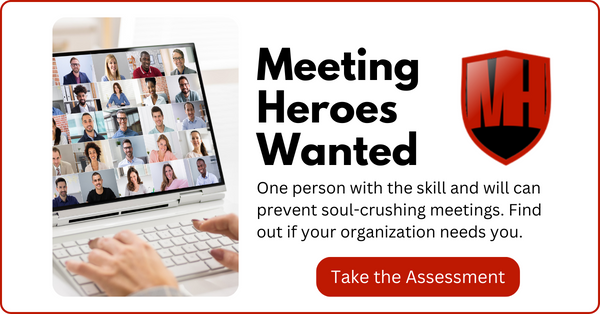Easily the number one complaint about meetings is that they are waste of time. They don’t make one bit of difference to anything that matters.
Dig into the complaint, and you’ll hear something like this…
“We do a lot of talking,
but there’s rarely any action.”
The action that they think is missing are decisions. People want to leave the meeting with closure, and that means generating options and deciding which to pursue.
Because you want to be a person of action, you need to be a person that helps a group decide.
You can do so by taking five specific actions when you are running the show. And even if you aren’t formally in charge, suggest these actions as an engaged, and helpful, meeting participant.
Tell people they’ve reached a decision point
The default activity in a meeting is discussion. That activity will continue until someone, and by someone I mean you, alerts the group that the default is no longer the right activity.
While it might seem obvious to you, others in the group might not recognize that they have arrived at a decision point. You can help them see this by saying something that shifts the activity. Try this…
“It looks like we have a decision to make.”
State what you view to be the question, and check with the group to see if they agree.
While you’ll later hear complaints if the group doesn’t make a decision, you may also get some resistance from some people in the meeting when you attempt to move from discussion to decision.
Discussion might be boring and somewhat unproductive, but for most people it’s safe and reasonably comfortable.
Decision-making, on-the-other-hand, feels a lot riskier. When people sense danger, they try to avoid it. In this case, they’ll simply keep talking.
Stick to original statement, “We’ve got to decide.” Then do your best to frame the right question for the group. Afterall, a decision is simply the answer to a question.
Caution: There are almost always multiple ways to ask the question and what you ask makes a big difference on what the answer is.
Clarify the options

Once people agree on the question, your next task is to identify options.
If you listen well to the preceding discussion, there are already some options that are obvious. In the simplest decisions, the status quo is usually one of the options, and making a change is another.
You can speed the process along, by telling the group the options you’ve already heard.
Don’t limit the group, though. Doing so will make folks cranky. Ask people what options they think should be included on the list of possibilities.
Try to keep people from talking about the options yet. You’re goal should be to simply identify the possibilities.
As each option is identified, it helps to write them down, so they are visible to everyone. This might be on a white board, flip chart, or within the collaboration tool you’re using for a virtual meeting.
Discuss decision criteria

You’re almost ready to cut loose the debate, but not quite yet.
Before people start to evaluate the options, it helps to first decide what criteria the group will use to make the choice.
If everyone agrees on the criteria, making the decision becomes a simple exercise in asking people to apply the criteria.
If participants don’t agree, things get a little trickier. That’s okay, it’s still better to have the argument about the criteria before evaluating specific proposals.
Allow everyone to have a say

One key to helping the group make the decision is to get them to stop evaluating the options. This point will not come until everyone has had a chance to voice an opinion.
Be proactive in asking all group members what they think. When you offer a general invite, you’ll likely only hear from the boldest group members.
The quiet ones may not speak up unless they are personally invited into the conversation. Don’t mistake their silence for a lack of opinion.
This conversation often goes a lot quicker if you structure it a bit. You might asks people to respond to specific questions such as:
- What do you see as the strengths/weaknesses of each option?
- Which option do you prefer and why?
- Which options would you be willing to support and why?
- Which options do you think should be eliminated and why?
Call for the decision
Eventually, you will sense that everyone has had his or her say. A simple thing you might say to the group at that point is…
“Are you ready to make the decision?”
If you get agreement, ask for everyone’s decision or vote. Use the results to determine what will happen next.
Using these strategies does not guarantee an easy decision, but will at least keep you focused on where you need to be, wrestling with the question.




